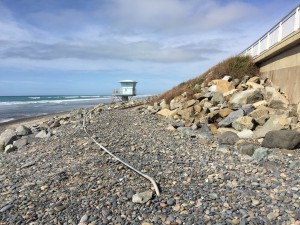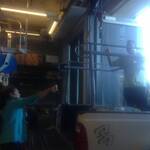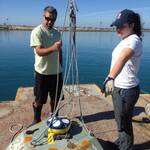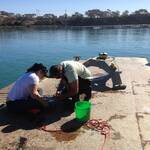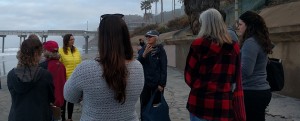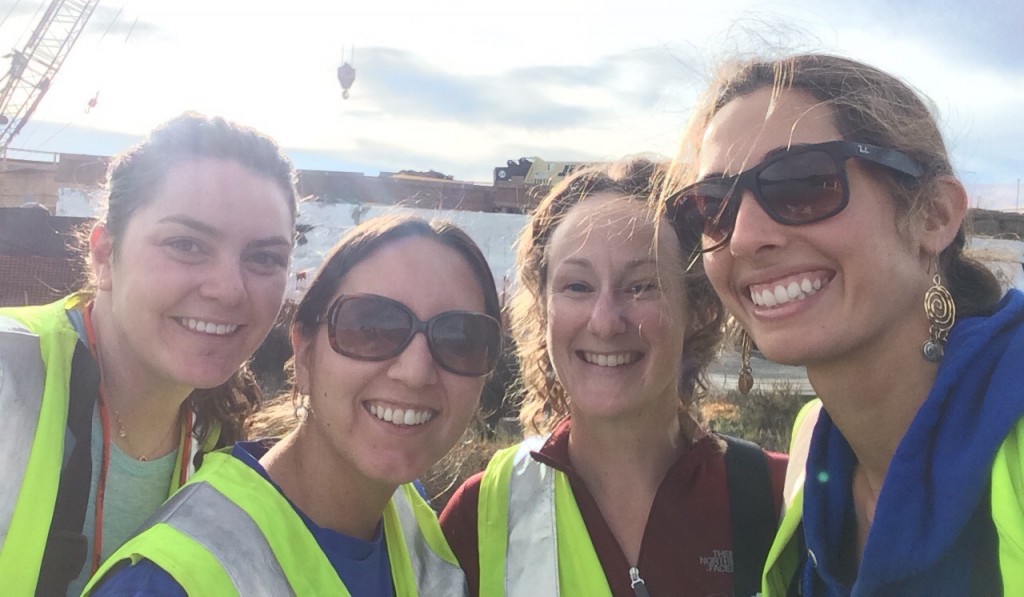The Tijuana River mouth closed last week in response to what we think are the combined effects of large waves throughout this El Niño season and potentially along-shore transport of sand from earlier beach nourishments. Our colleagues at the Tijuana National Estuarine Research Reserve have been monitoring the situation closely to better understand what is going on. See this news article about some of the unfortunate consequences of this closure combined with significant water quality issues from upstream. A paper by colleagues in the Guza lab should be coming out soon that looks at the beach component of this issue. While several of the smaller estuaries throughout California close more regularly, a closure of this estuary has not occurred since the last major El Niño in 1983.
El Niño and Our Urban Ocean
Sarah joined Julie Thomas from SCCOOS to talk about impacts of the current El Niño on our coastline at the Birch Aquarium’s Perspectives on Ocean Science Lecture Series. There was an excellent turnout and a lot of interest by the community. A brief news clip of the talks is here, a full recording will be available soon.
beach walk & citizen science studies

Maddie explains her research in Los Peñasquitos Lagoon to beach walk participants.
Our beach walk was a great success! We saw extreme beach erosion, infrastructure damage, and a recently excavated estuary mouth.
Astrid Hsu, MAS student at SIO Is studying the efficacy of beach walks and the Urban Tides Citizen Science Initiative, both to figure out who and why people join the Initiative and whether citizens are learning something from their participation. Click “read more” below to read preliminary findings of Astrids’ results! And if you want to participate check out the Urban Tides Initiative website (for those that want to use an app and/or on-line program) and the Storm Photo website ( for those who would rather send images via email). More information about El Niño and its effects see here.
beach walk this weekend!
Join us for a beach walk this Saturday, March 5th 3:30pm at Torrey Pines. We will highlight coastal changes we are experiencing during this El Niño season including cliff and beach erosion and drastic changes to the estuaries. We will also introduce the Urban Tides Initiative, a citizen science initiative intended to document coastline change. The walk will start at theTorrey Pines State Reserve South parking lot near the restrooms (directions). From there we will briefly walk south and then head north, passing the mouth of Los Peñasquitos Lagoon and ending near the cliffs north of the lagoon. The walk should take ~1-1.5 hours. Note that a chance of rain and large waves are predicted, so long as it is not pouring, we will do the walk. In the case of very large waves and high water level, we will walk along the roadway rather than the beach. We look forward to seeing you there!
This weekend should be a particularly interesting time to check out the region as it recently experienced a few cliff failures, massive beach erosion, a closed estuary mouth (see above photo), and mechanical breaching of the estuary is expected to occur Friday before our walk. The photo above is from 18 February 2016, shortly after a cobble berm blocked the estuary mouth and the beach access ramp (note the hand rail barely sticking up above the cobbles!).
Ocean Sciences 2016
The Giddings’ lab just returned from the 2016 Ocean Sciences Conference in New Orleans. Isa gave an excellent talk (her first science talk at a major conference, congrats!) and Maddie presented a great poster with exciting new data. This was the view above the poster hall… a sea of posters and ocean scientists!
deployment in Agua Hedionda Lagoon
Due to receiving a newly funded USC Sea Grant project, we deployed a mooring in Agua Hedionda Lagoon to compare the influence of waves and wave-current interactions on sediment transport in a more open-water type of lagoon.
- we used our lab crane for the first time to load gear, awesome!
- Kent and Maddie discuss the deployment plan
- Maddie and Kent prep the mooring for deployment
Thanks to the Carlsbad Aquafarm for their help in mooring deployment and the Hubbs-SeaWorld Research Institute for access to a location to mount our time-lapse camera!
citizen science highlighted on KPBS
KPBS joined our beach walk on 20 January 2016 and featured a great story on the radio and on-line about the Urban Tides citizen science program as well as the science many of us at SIO are doing to document El Niño’s impact on our coastline. KPBS has been working on a series of El Niño related stories, also check out this great one on Bob Guza’s beach monitoring program. Another story highlighting some of the science recently funded related to this El Niño season (including our CA estuary comparisons with SCCWRP ) is available here.
beach walk & citizen science!
20 January 2016, Sarah, Maddie & Astrid joined a beach walk on La Jolla Shores to explain extreme water level events, El Niño, sea level rise, and to introduce folks to the Urban Tides citizen science initiative. The Urban Tides Initiative and the walk are led by USC Sea Grant. Astrid Hsu is a Master of Advanced Studies student in Marine Biodiversity and Conservation at SIO interested in science communication and the process of citizen science. She is helping gauge the success of the Urban Tides citizen science program through surveys and web-data analysis.
Check out a wonderful blog that Astrid wrote about the beach walk here, and another one here!
Maddie Harvey gave a tour of the SIO pier and Sarah Giddings spoke briefly about sea level rise, El Niño, and what scientists are able to do with the photographic dataset collected via Urban Tides. We are still looking for participants, so please consider joining in this great citizen science project to document changes to our coastline (beaches, estuaries, cliffs, and infrastructure) throughout this winter!
lagoon field work continues!
The lab spent the past two days in the field collecting data for Maddie’s lagoon morphodynamics project. The photo here is from Los Penasquitos Lagoon prior to conducting morphodynamic and hydrodynamic surveys following a series of major storms. The estuary looks very different after those storms. Unfortunately none of our arms are long enough to show our excellent oversized lagoon waders + safety vests! Crane in the background is because the railroad bridge over Los Pen is under construction.


